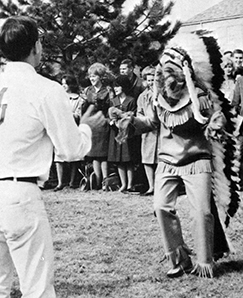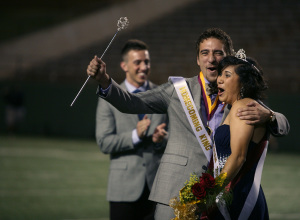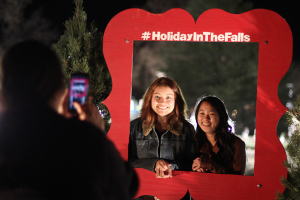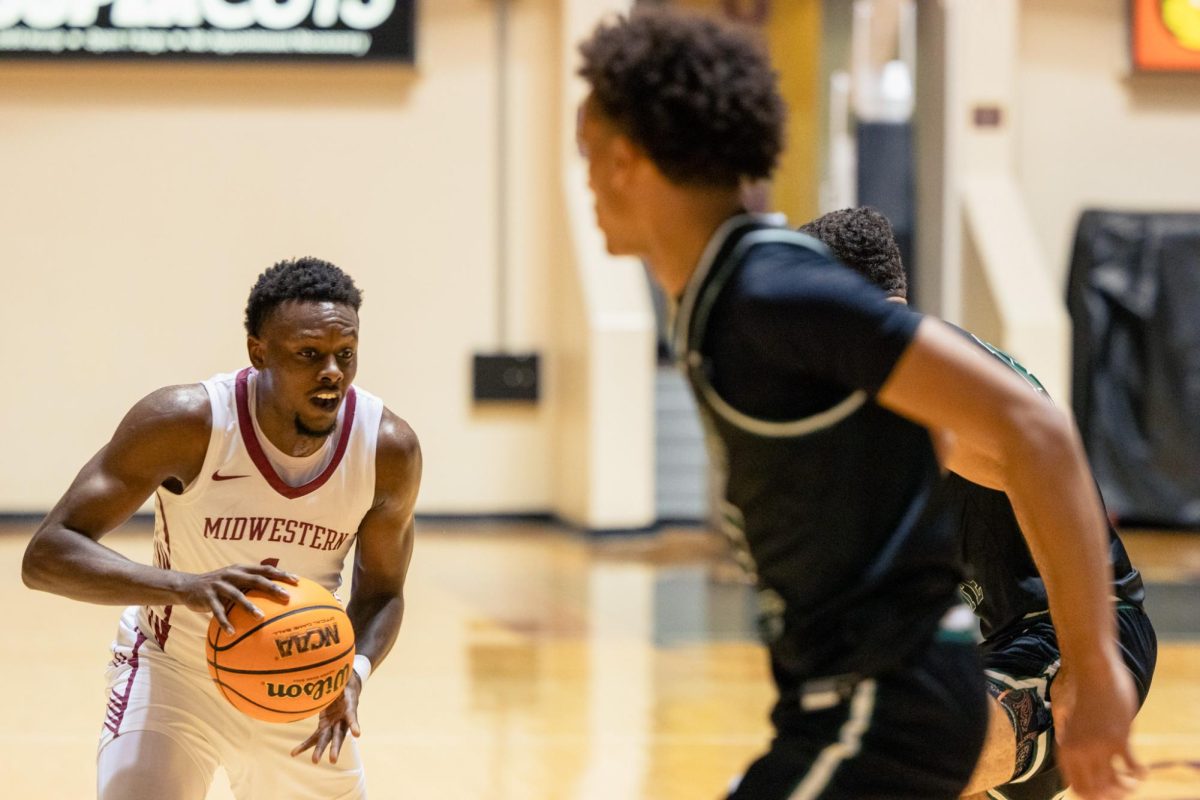From its beginnings in 1922 as a municipal junior college housed within a high school building, Midwestern State University has become a campus of 255 acres and 70 buildings offering a variety of academic programs in liberal and fine arts, mathematics, sciences, business and applied sciences. Whether alumni consider themselves Indians or Mustangs, the university, now with about 5,200 students, has carried on a tradition of pride and community.
By Sarah Shelton
Wichita Falls got its name from the first settlers of the area in the 1700s, the Choctaw Indians. The name “Wee-Chi-Tah” meant “waist deep,” which was then a description of the river the Indians built their tribe around.
“Back in middle school we learned about the Indian tribe that sent one of their women into the river to test its deepness and cross it,” said Melody Gregory, a junior in art. The sculpture depicting the legend can be found on Wichita Street, off Martin Luther King Jr. Blvd.

Created in 1922 as Wichita Falls Junior College, the second municipal junior college in Texas, MSU’s earliest home was in Wichita Falls High School with which it shared both the building and faculty. Later, a legislative act and a vote of the people of Wichita Falls set up a separate tax district to support the junior college.
In 1937 the college acquired a new, 40-acre campus of its own on the south side of town. The recently finished Hardin building rose above pastures and wheat fields, an impressive Spanish colonial structure complete with a lofty bell tower. In that year the college was renamed Hardin Junior College in honor of Mr. and Mrs. John G. Hardin.
In January 1950, the name changed to Midwestern University, the junior college division remaining Hardin Junior College. During that time, wider recognition came to the school.
Another change in the school’s status came Sept. 1, 1961, when the 56th Texas State Legislature made Midwestern University part of the Texas Colleges and Universities System, and the junior college division was dissolved.
In 1975, the Texas Legislature changed the name to Midwestern State University.
From Indians to Mustangs
In 2006, MSU changed its mascot from an Indian to a mustang named Maverick. The Indian served as the university’s mascot for 83 years before being retired.
The NCAA deemed any “hostile” Native American mascot or logo as abuse to the Native American imagery and names, which resulted in changes made to the NCAA-sanctioned events, no longer allowing American Indian logos.
“I remember the townspeople being angry because people didn’t think it was a big deal being the Indians,” said Amanda Jefferson, a Wichita Falls native and junior in sociology.
“I saw some of the Native Americans that were interviewed about it didn’t care or show to have any problems with the mascot,” said Logan Canafax, a junior in art. “They took it as a compliment because they were being recognized as the ones who settled here first. I wish we were still the Indians. We have enough mustangs in the area.”
The campus still honors Native Americans with street names and statues like that of the Sunwatcher that commemorates the university’s 75th anniversary and represents the South Plains Indians.
Homecoming rituals

Homecoming is a week-long event that provides activities for students, alumni, family, and friends. Every year there is a school parade that travels throughout campus.
“There are tons of traditions during homecoming week. It brings different social groups together, and the rivalry is pretty cool during competitions like building the best float. And you get to go all out with school spirit,” said Mark Broomfield, a junior in exercise physiology.
The homecoming cardboard boat race is one of the annual events where student organizations attempt to construct a cardboard boat that will successfully make its way across Sikes Lake. Following the boat races, the Kiowa Kooks, a group of alumni cooks, host the Fish Fry event.
“You can only use duct tape and cardboard to make the boat, and really you just have to strategize with the people in the boat to make it across without sinking,” said Taylor Courtney, a freshman in radiology and member of Sigma Kappa.
The homecoming bonfire is known as the official pep rally before the big homecoming game. Throughout homecoming week, students can trade in other university T-shirts in exchange for a bonfire T-shirt, and other universities’ T-shirts will be added to the bonfire collection which will later all be burned down.
“The bonfire was pretty fun, and I liked seeing the Tarleton shirts on there,” said Katie Brown, a sophomore in kinesiology. “I thought it was pretty neat that the coaches of the current sports would all join and get to start the bonfire.”
A torchlight march is held before the bonfire where students can join in. Waliking around campus holding lit candles with their peers, students follow the marching band as it makes its way to the bonfire pep rally.
“I had a great time during homecoming,” Spencer said. “My favorite part was the march because I got to play the quads and everybody just joins in while we’re walking through campus.”

Starting in the late 1920’s, the Burns family of Wichita Falls began their first Christmas celebration together by setting up a small Christmas tree on their front porch with one single bulb. As the years passed and Mr. Burns became more successful in the oil industry, the couple was able to add onto their tradition. Each year they would add a new display to the whole scenery.
In 1954, Mr. Burns died in a car accident, but Mrs. Burns continued the tradition in memory of her husband. From 1954 to 1970, during the Christmas season, Mrs. Burns would turn her front lawn into an animated display with brightly-colored lights. At that point, the display had become so large and detailed that Mrs. Burns had to hire help to maintain it every year.
In 1971, Mrs. Burns passed away, and the display was discontinued. In her will she left the decorations to her son, or he could donate it to Archer City. However, the display remained in storage for the next three years until the death of the her son. Archer City offered the display to MSU as long as it was operated to the public free of charge.
When MSU received the display, it did not have the funding to run and maintain it, so the Fantasy of Lights Committee was formed, making the MSU-Burns Fantasy of Lights a success that is still in practice today. Volunteers from the university, local citizens and airmen from Sheppard Air Force Base all contributed to the maintenance of the display in order to have it ready for its 1974 appearance.
“I’ve gone since I was able to walk,” Canafax said. “The reason we always went is because when my grandma was a kid, she saw it start out in the Burns’ yard. She lived out in Valley View so if she could make it into town around Christmas, it was a big deal for her. Now she likes to take us and reminisce about when she saw it as a kid.”
WeatherAs a part of “Tornado Alley,” Wichita Falls has gone through its share of scares during tornado season; the most infamous incident being “Terrible Tuesday.” On April 10, 1979, a mile-wide tornado struck the town, killing 42 people and destroying more than 20,000 houses and buildings. The tornado caused $400 million in damage.
“I didn’t really know anything about Wichita Falls or its past with tornadoes before I got recruited here for basketball,” Brown said. “The first time I heard the sirens running a drill, I was in the shower, so I thought I was screwed. I’m not used to the sirens every month.”
Sheppard Air Force Base
Wichita Falls is home to Sheppard Air Force Base, named in honor of Senator Morris Sheppard, former chairman of the Senate Military Affairs Committee. The Base, which opened on Oct. 17, 1941, trained aircrew and aircraft mechanics during World War II. Today, SAFB is the largest and most diverse training base in air education and training command in the United States–the only Air Force base that is home to both technical and flying training. It has a daily population of 15,00 and annually graduates 62,000 airmen and airwomen.
“I lived on base for a couple of years, but I’ve been going my whole life, whether it was getting groceries, work, or I’ll still get my hair cut on base,” said Branson Spencer, a freshman in music.
During the 1920’s oil industry boom, a conman and Amarillo contractor by the name of J.D. McMahon made his mark on the city by creating the world’s smallest skyscraper and getting away with it. McMahon planned with investors to create a multi-story office building that would overlook Oklahoma. The proposed skyscraper was expected to be a 480-foot building, but what McMahon purposefully did not mention to his investors as they signed off on his contract was that his blueprint measurements were measured in inches rather than feet, resulting in a 480-inch (40 ft) skyscraper. It wasn’t until the construction was complete, and McMahon and the estimated $200,000 invested in the project were gone, that anybody realized what McMahon did. Featured in “Ripley’s Believe it or Not,” the building is still a visible landmark in downtown Wichita Falls on the corner of Seventh Street and LaSalle.
“I found out about it in my photo class, and we went and visited the site,” said Nicole Kutzer, a senior in art. “It’s a cute building, and the story behind it is hilarious.”
The Falls
The city also had an waterfall, but it washed away in a flood in the 1800s. However, in 1987, city workers constructed a 54-foot man-made waterfall in dedication to the original falls. Southbound motorists on I-44 or and visitors to Lucy Park can see the new verion of the falls, now part of the character of the Texoma landscape.
“Everyone says that it (the town) gets dead, but it’s really diverse,” Brown said. “You have the country scene down the road, but there’s the city, too. If you find the right group of friends you can make it fun.”
Brick
Over time, MSU also developed a tradition surrounding the look and feel of the buildings on campus — all with “MSU brick” covering the exterior of the buildings.
“That was true at one time,” Everett Kindig, history professor and author of The Better Part of a Century, a book on the history of Midwestern State University, said. At one point, basically there was only one supplier of brick.
However, eventually that changed, making the original brick obsolete.
“There was a source for the original brick and then everybody basically quit making it,” Kyle Owen, associate vice president for facilities services, said.
But that didn’t stop the buildings from being covered in brick.
Debbie Barrow, director of board and government relations, said a company in Texas developed the MSU brick that was used in all campus buildings but over the years the original materials used to make the brick ran out.
“When we built the Dillard building, they came with some new bricks and we had to see which bricks matched the best,” she said. “The original MSU brick is no more. But the replacement has seemed to serve us well since Dillard was built.”
CLICK HERE for more information on MSU traditions
[Editor’s note: The printed version of this story contained an error in the spelling of Logan Canafax’s name. The Wichitan apologizes for the error.]
THANKS TO OUR SPONSORS
Foreign Languages of Midwestern State University
Student Affairs and Enrollment Management















